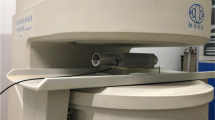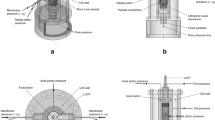Abstract
Determining the influence of effective stress on rock deformation is essential for geotechnical stability analysis in oil and gas production. There is no universal effective stress coefficient for all rock properties, and different values of effective stress coefficient apply for different physical quantities (Gurevich, 2004). Although the effective stress law and its application is not new, frequently overlooked or misapplied. Hence, a novel method was proposed for measuring and calculating the effective stress coefficient in this work. Firstly, pore compressibility under different confine pressure values was measured using reservoir fluid or experimental fluid. Secondly, effective stress was calculated by comparing pore compressibility under different confine pressure and then, the range of effective stress coefficients was determined eventually. Finally, the reliability of the proposed method was validated via the stress-sensitive curves of tight sandstone core samples and by comparing the results with those of two other calculation methods for the effective stress coefficient. This work suggests that the stress-sensitive curves of the two core samples from the same location and with similar physical properties have given similar effective stress coefficient (η = 0.201) calculated using the proposed method, which indicates that the calculation is reasonable. The comparison of the proposed method with other methods also indicate that the proposed technique is reliable.
Similar content being viewed by others

References
Bear, J. (1972). “Dynamics of fluids in Porous Media.” American Elsevier Publishing Company (ISBN-13:978-0-486-65675-5, pp. 59-113) New York.
Bernabe, Y. (1986). “The effective pressure law for Chelmsford granite and Barre granite.” Int. J Rock Mech. Min. Sci. Geomech. Abstr., No. 23, pp. 167–175, DOI: 10.1016/0148-9062(86)90972-1.
Bernabe, Y. (1987). “The effective pressure law for permeability during pore pressure and confining pressure cycling of several crystalline rocks.” J. Geophys. Res., No. 92, pp. 649–657, DOI: 10.1029/JB092iB01p00649.
Biot, M. A. (1941). “General theory of three-dimensional consolidation.” J. Appl. Phys, Vol. 12, No. 155, pp. 155–164, DOI: 10.1063/1.1712886.
Bodaghabadi, S. and Moosavi, S. J. (2008). “A simple practical method to determine the biot coefficient for hydromechanical analyses.” ISRM International Symposium-5th Asian Rock Mechanics Symposium. International Society for Rock Mechanics, pp. 227–229.
Chen, M. (2000). “Experiments and analysis on hydraulic fracturing by a large-size triaxial simulator.” Chinese Journal of Rock Mechanics and Engineering, Vol. 19, No. s1, pp. 868–872.
Dassanayake, A. B. N., Fujii, Y., Fukuda, D., and Kodama, D. (2015). “A new approach to evaluate effective stress coefficient for strength in Kimachi sandstone.” Journal of Petroleum Science and Engineering, Vol. 131, No. 07, pp. 70–79.
Gurevich, B. (2004). “A simple derivation of the effective stress coefficient for seismic velocities in porous rocks.” Geophysics, No. 60, pp. 393–397, DOI: 10.1190/1.1707058.
Li, M. and Xiao, W. L. (2008). “Experimental study on permeabilityeffective-stress law in low-permeability sandstone reservoir.” Chinese Journal of Rock Mechanics and Engineering, Vol. 27, No. s2, pp. 3535–3540.
Ojala, I. O. and Fjær, E. (2007). “The effective stress coefficient in porous sandstone.” Proc, 1st Canada-US Rock Mechanics Symposium. American Rock Mechanics Association. 27-31 May, Vancouver, Canada.
Qiao, L. P., Wong, R. C. K., Aguilera, R., and Kantzas, A. (2012). “Determination of biot’s effective-stress coefficient for permeability of nikanassin sandstone.” Journal of Canadian Petroleum Technology, Vol. 51, No. 3, pp. 193–197, DOI: 10.2118/150820-PA.
Terzaghi, K. (1924). “Die theorie der hydrodynamischen spannungserscheinungen und ihr erdbautechnisches anwendungsgebiet.” Proc., First International Congress for Applied Mechanics, Delft, The Netherlands, 22-26 April, pp. 288–294.
Terzaghi, K. (1936). “The shearing resistance of saturated soils and the angle between the planes of shear.” Proc. First Int. Conf. Soil Mech., Harvard Univ., Cambridge, Mass, No. 1, pp. 54–56.
The Oil and Gas Professional Standards Compilation Group of China, (2002). SY/T 5358-2002 the Evaluation Methods of Reservoir Sensitivity and Liquidity, Pet. Ind. Press, Beijing.
Warpinski, N. R. and Teufel, L. W. (1992). “Determination of the effective-stress law for permeability and deformation in lowpermeability rocks.” SPE Formation Evaluation, Vol. 7, No. 2, pp. 123–131, DOI: 10.2118/20572-PA.
Warpinski, N. R. and Teufel, L. W. (1993). “Laboratory measurements of the effective-stress law for carbonate rocks under deformation.” In International Journal of Rock Mechanics and Mining Sciences & Geomechanics Abstracts, Vol. 30, No. 7, pp. 1169–1172, Pergamon.
Zheng, L. L., Li, M., Xiao, W. L., and Zeng, L (2008). “Determination of effective stress coefficient of permeability using maximumlikelihood function approach.” Xinjiang Petroleun Geology, Vol. 29, No. 6, pp. 747–749.
Author information
Authors and Affiliations
Corresponding author
Rights and permissions
About this article
Cite this article
Shen, Y., Luan, G., Zhang, H. et al. Novel method for calculating the effective stress coefficient in a tight sandstone reservoir. KSCE J Civ Eng 21, 2467–2475 (2017). https://doi.org/10.1007/s12205-016-0514-5
Received:
Revised:
Accepted:
Published:
Issue Date:
DOI: https://doi.org/10.1007/s12205-016-0514-5



